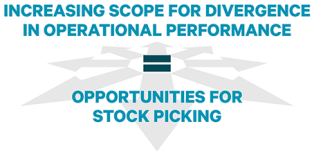Insights

The Supply Chain Revolution
Fund Manager
FOR INVESTMENT PROFESSIONALS ONLY
Supply chains are particularly topical in the current political climate with duties, tariffs and the location of factories much discussed by the media and corporates alike. In this latest Investment Insight from Davy Asset Management, Jonty Starbuck, Fund Manager of the Davy Global Brands Fund, looks at how global companies are adapting supply chains in the midst of the “The Fourth Industrial Revolution”.
Using technology the right way
In the first of a series of Insights in July 2016 we discussed our observations on how the 'The Fourth Industrial Revolution' – the rapid adoption of new technologies enabled by the digital revolution – is impacting industries and business models in various ways. Technological change clearly isn’t only about the internet and social networks. In this Insight we focus on how supply chains are being adapted, and discuss the potential for innovations in areas such as manufacturing to improve a company’s earnings growth potential and provide management with greater flexibility in the years to come.

Our research suggests leading consumer goods companies have been looking at ways to localise production for several years, driven by the need to manage wage inflation in the developing world, reduce material waste and provide greater agility and flexibility in a rapidly changing retail environment. Indeed, companies such as Nike and Samsonite have been looking at ways to use new automated manufacturing technology to shift production closer to consumers, in both the US and Europe for many years, to save costs and manage inventory levels more efficiently. This is a trend we expect to continue, with or without changes to border tariffs or import duties in the US or Europe.
Before we delve into the detail, it is worth stepping back to ask why supply chains are important. When we analyse businesses, we are constantly looking for ways that management teams can create and nurture competitive advantages. With a few notable exceptions, an efficient supply chain and distribution capabilities are generally thought of as an undifferentiated 'right of passage' in most industries. This isn’t to say that getting the basics right isn’t important: during CEO Paul Polman’s initial efforts to turn around Unilever’s operating performance, improving on-shelf availability of its products accelerated sales growth by 1-2% in some developed markets. However, at a more fundamental level, we believe the application of new technologies is changing the rules of the supply chain management game in some industries, with considerable opportunities for industry leaders that are at the vanguard of innovation.

One company that we believe to be at the epicentre of change is UPS, the global leader in single package delivery. At a recent investor day, UPS detailed plans to increase investment in its Network Planning Tool which manages its EDGE (Enhanced Dynamic Global Executions) and ORION (route optimisation) systems. We believe these investments are essential to optimise a delivery network that is adapting to a structural shift towards B2C business driven by the rise of e-commerce. EDGE is a series of technology initiatives, started in 2015, designed to improve planning and execution. It uses real-time data to assign tasks and develop operating plans. UPS is also using artificial intelligence (AI) vendors such as IBM to integrate chatbots at its customer services centres and integrate with mobile devices to customise delivery preferences. Management recently revealed that 40% of its ground operations in the US are now automated, with old plant that is automated increasing productivity by 25% compared to 35% uplift for new build capacity. We believe these investments are essential to stay ahead of competitors and will ultimately lead to improving operational leverage at the group.

Another company we believe to be at the forefront of the manufacturing revolution is Nike. Over the last 25 years, Nike has built the third-largest design patent portfolio in the US while developing innovative platforms such as Nike Air, Dri-Fit, Free, Lunar and Flyknit. Management recently committed to double the speed of its supply chain efforts and cut its average product creation cycle in half. The company is increasingly looking to experiment with 3D printing to enhance performance, personalisation and increase speed to market by locating production plants closer to consumers. These additive manufacturing processes also offer scope to drive a significant reduction in waste. As of 2015, $1 billion of material costs did not end up in Nike’s end products. To summarise, we believe that these efforts offer significant scope for gross margin enhancement over time while also improving Nike’s ability to respond to consumer trends.
Why do we think this is interesting?
We believe these investments in technology will generate returns and create competitive advantage over several years which is beyond the horizon of most analysts. Research is required to understand how technology will affect dynamics in different industries and identify where profitability can be transformed. We believe this approach holds promise for active investors to capture excess returns over long time horizons.
Please click here for Market Data and additional important information.
To read more Insights click here.